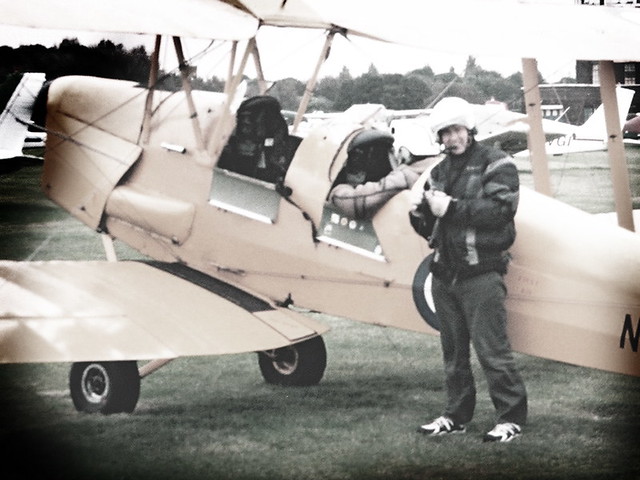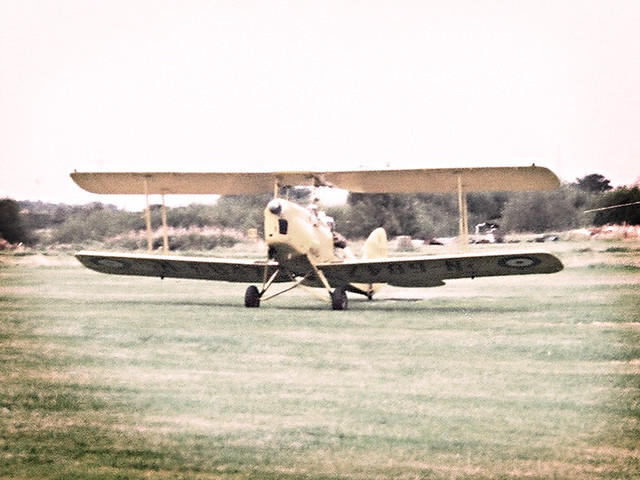A disembodied voice crackled in my ear piece.
“Now it’s your turn to take over the controls.”
There’s one thing screaming about the skies in the virtual safety of a Playstation game, it’s another thing completely when you’re in the domain of the birds clutching at the joystick of an old bi-plane.
As birthday presents go, it had been inspirational. My sister had arranged one of those adventure packages. This one was to fly a Tiger Moth.
The idea of taking to the skies in something made out of wood and wires seemed a potential way to bring my bucket list to a premature and grisly end. As a result I waited almost the full 12 month period on the voucher before plucking up the courage. With time running out I eventually took the plunge and booked the flying lesson.
Preparation
The instructor did his best to make me feel at ease by jokingly that the Tiger Moth was simple to fly as it only had a few controls. As he put it: “There are more instruments in a three piece band.”
That didn’t help. I like instruments and controls and banks of flashing buttons, especially when one of them is labelled ‘ejector seat’.
His second attempt at a nerve-soother was no better.
“This is a really lucky plane,” he cheerily pointed out. “It’s been shot out of the skies or crashed at least three times… and it’s still flying.”
I don’t consider a plane with a record of plummeting to earth particularly blessed with good luck.
My state of mind improved when he handed me a leather jacket and a helmet. I probably looked more Snoopy than Tom Cruise but in my head I was Top Gun.
It was time to get airborne.
Flying a Tiger Moth Plane
Nervous as hell but feeling pretty cool in my flying jacket, I squeezed into the front seat cockpit on an airplane which pre-dated the First World War. The real pilot sitting behind me had that typical pilot’s voice; the sort that you imagine would never get flustered even when the engines fail, the joy stick snaps off in his hand and a distracted pigeon flies straight into the goggles.
Take off wasn’t quite the same as taxiing in a passenger jet to somewhere hot and exotic. The little plane bumped along the ground, bouncing on every divot, with what seemed the acceleration capabilities of a moped.
We hadn’t even reached a speed where I’d have shifted to third gear in my car when the pilot pulled back on the joystick and, by some miracle, the plane actually took to the air.
We’d barely cleared the airfield’s blades of grass when the pilot suggested I take over the controls.
The instructor really hadn’t been joking about the instruments. There was the joystick (more of a metal rod) which was attached to the rudder and the plane flaps by wires that looked as though they once been metal coat hangers. Then there was the speedometer and the fuel gauge. That was it.
Flying the machine was ridiculously simple. You want to go left; you push the joystick to the left. You want to climb; you pull it back and so on. You could throw the joystick around and the Tiger Moth would react in a lovely, calming, leisurely manner as if it had sneaked a spliff beforehand and was in no mood to be rushed. Playstation controls for flying a plane are way, way more sensitive and difficult.
To keep flying straight you line up the point where the wires which connect the wings make an X (conveniently located directly in front of the pilot’s seat) with the horizon. That’s the Tiger Moth’s version of the artificial horizon instrument. It made me wonder how they ever flew at night but, as I was concentrating on not sending us into a tail spin, I didn’t ask.
The Tiger Moth had a top speed of about 80mph (I’d driven faster on the way to the airfield) which to me seemed far too slow to keep something this size in the air. But it actually turned out to be a major plus.
The slow speed made it feel as though I was gliding above the green and pleasant land like a bird rather than in a flying machine. As I relaxed into having control of the plane and banked in long, lazy circles, I took my eyes from the wiry X to watch farmers and their livestock in the fields below.
For a short magical time I was transported to another era; I was Denys Finch Hatton in Out of Africa… even if the location was really more out of Manchester.
You could say the time flew past before the pilot took over the controls again to bring the little plane gently down on to the soft grass.
By that time we taxied to a stop I couldn’t imagine how I could ever have been worried about flying in such a lovely old plane.
A voucher to fly a Tiger Moth at Barton Airfield (City Airport) costs from £155 and is valid for 12 months (although the flying period is April to October).
Jack is co-owner, writer and photographer for BuzzTrips and the Real Tenerife series of travel websites plus lots of other things. Follow Jack on Google+







Be the first to comment